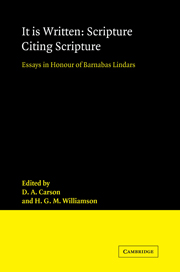Book contents
- Frontmatter
- Contents
- Preface
- Biographical note
- Abbreviations
- 1 An assessment of recent developments
- THE OLD TESTAMENT IN THE OLD TESTAMENT
- BETWEEN THE TESTAMENTS
- 6 Translating the Old Testament
- 7 Retelling the Old Testament
- 8 Commenting on the Old Testament
- 9 Citing the Old Testament
- 10 Apocalyptic literature
- THE OLD TESTAMENT IN THE NEW TESTAMENT
- Indexes
8 - Commenting on the Old Testament
Published online by Cambridge University Press: 16 January 2010
- Frontmatter
- Contents
- Preface
- Biographical note
- Abbreviations
- 1 An assessment of recent developments
- THE OLD TESTAMENT IN THE OLD TESTAMENT
- BETWEEN THE TESTAMENTS
- 6 Translating the Old Testament
- 7 Retelling the Old Testament
- 8 Commenting on the Old Testament
- 9 Citing the Old Testament
- 10 Apocalyptic literature
- THE OLD TESTAMENT IN THE NEW TESTAMENT
- Indexes
Summary
THE PESHARIM
Of the documents or fragments of documents which have been discovered at Qumran, perhaps the most distinctive are the pesharim. Formally, they are continuous interpretations of the biblical passages to which they relate, Habakkuk (1QpHab), Micah (1QpMic), Zephaniah (1QpZeph and 4QpZeph), Psalms (1QpPs and 4QpPs [a, b]), Isaiah (4QpIsa [a−e]), Hosea (4QpHos [a, b]) and Nahum (4QpNah). Other fragmentary material might also have belonged within pesharim (cf. Horgan, 1979, p. 1; Horgan's edition of the Hebrew texts is to be found in an appendix, here cited with ‘I’ before the arabic numeral of the page number), so that the task of identification must continue. The most complete of the pesharim is that of Habakkuk, which has been subjected to diligent investigation since the publication of Elliger's magisterial treatment (1953). By reason of its relative completeness and the close attention it has attracted, 1QpHab is a suitable point of departure for understanding the pesharim generally.
1QpHab is commonly cited by column and line of text, as here, but it proceeds systematically in the order of Habakkuk, until Hab. 2:20 is cited in the thirteenth column. The pesher therefore ends on the openly eschatological climax of what is called the ‘burden’ of Habakkuk in 1:1, and does not take up the ‘prayer’ of Habakkuk, from 3:1. On both external and internal grounds, the ending of the document should be seen as the result of a deliberate decision; blank space follows the four lines of the thirteenth column, and the chief concern of the pesher appears to be unequivocally eschatological (cf. Brownlee, 1979, pp. 2i8f for an unrepresentative attempt to explain the ending as accidental).
- Type
- Chapter
- Information
- It Is Written: Scripture Citing ScriptureEssays in Honour of Barnabas Lindars, SSF, pp. 122 - 140Publisher: Cambridge University PressPrint publication year: 1988
- 1
- Cited by

